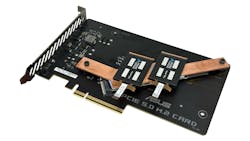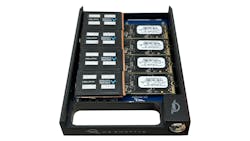This article is in the TechXchange: Cool Designs and the Flash Memory Summit 2023 digital issue.
In any electronic design, power management is as much about managing thermals as it is about limiting power losses that cause excess heat in the first place. While the electronics industry rolls out faster processors and memory chips to meet the need for speed in everything from PCs to data centers, existing technologies like heatsinks and forced-air-cooling fans are struggling to keep pace.
Or at least that’s the opinion at Frore Systems, a startup that recently announced the availability of what it calls the world’s first silicon chip for actively removing heat from the processors in electronic devices.
Fan-less Heat Removal
The San Jose, Calif.-based company rolled out a MEMS-based cooling device called AirJet that can remove heat without fans. Instead, it uses ultrasonic vibrations to blow air through the device and over processors that suffer from thermal constraints.
As a result, the AirJet fits in a compact form factor not unlike an ultra-thin heatsink, but it can remove roughly the same amount of heat as the cooling fans it replaces. The module is designed to run on minimal power consumption while staying virtually silent.
Though it was only founded in 2018, Frore Systems said its AirJet cooling technology is already getting a hard look from “five of the world’s top ten device manufacturers” and several leading chip companies.
Intel has plans to collaborate with the company to build AirJet into future laptops in its Evo hardware reference platform. Qualcomm, which is contributing funding to the startup, is collaborating with Frore, too.
Though positioning AirJet primarily as a CPU cooler, Frore is also adapting the technology to take heat out of memory chips as well, in large part due to the AirJet’s ultra-thin form factor. It recently partnered with Phison to apply its AirJet cooling technology to a PCIe Gen5 NVMe SSD that can support sequential read speeds of more than 14 GB/s. These M.2 SSDs tend to run hot, requiring huge heatsinks.
Why Thermal Management is Vital to Computing
As the company’s founders—Seshu Madhavapeddy (CEO) and Surya Ganti (CTO)—see it, heat is one of the biggest bottlenecks facing the electronics industry, and better thermal management is key to solving it. To handle heftier workloads, semiconductor firms are rolling out processors, memory, and other ICs that can process data and transfer it around a system faster. The tradeoff? More power is inevitably lost to heat.
Unless these chips are throttled to prevent overheating or purposely cooled to dispel it, heat can collect inside them, sapping their performance and power efficiency, or even causing permanent damage under heavy loads.
Heat can drain as much as 50% (or even more, in some cases) of a processor’s total performance, said Frore. Thus, care must be taken when designing a system to dispel heat as fast as possible.
Traditionally, engineers use heatsinks to remove heat from the surface of chips or fans to actively air-condition them. While these cooling systems suffice in situations where space isn’t at a premium, they’re typically too bulky, noisy, and impractical for most mobile devices, including portable laptops and even smartphones.
For its part, Frore Systems is taking advantage of microelectromechanical systems (MEMS) in a bid to dissipate the heat more efficiently than bulky heatsinks, mechanical fans, or other approaches to cooling.
AirJet bears more of a resemblance to a passive heatsink than other active cooling systems. The AirJet sits on top of a processor or memory device. But instead of passively whisking heat away from the surface of the silicon, the AirJet actively cools the device by drawing in air from four vents housed on the top of the cooling device, sends it through a heat spreader physically touching the device, and then silently blows it out.
A series of silicon membranes vibrate at ultrasonic frequencies to create pulsating jets that suction air from outside and, once the air enters the interior of the cooling device, push it through. The heat spreader in contact with the processor or other component saturates the air with heat, and the pulsating jets subsequently blow the balmy air out the other side of the system through a side-mounted spout in the heatsink.
The AirJet fits into such a minuscule form factor that it can dissipate heat from devices that typically lack the space for traditional cooling systems, like fans, and thus must be cooled using passive cooling alone.
AirJet is apparently not only lighter and smaller, but also more powerful than traditional cooling fans. It supports up to 10X stronger pressure, which helps it suction air from outside and, once hot, expels it.
Inside AirJet: Active Cooling that Looks Passive
The startup has started shipping several different AirJet devices, including the AirJet Mini, only slightly larger than a quarter, and the AirJet Pro, roughly twice that area, to address different (mostly consumer) devices.
Well-suited for smartphones, wearables, tablets, and other devices that typically lack space for cooling, the AirJet Mini delivers 5.25 W of heat dissipation when the temperature of the silicon die it’s mounted to is 85 °C. The module weighs in at 11 grams and measures 27.5 mm wide × 41.5 mm long × 2.8 mm thick, but unlike heatsinks and other passive cooling devices, it consumes power to dispel heat from the system. The Mini uses 1 W of power at a maximum, and it outputs 1,750 Pascals of back pressure.
The Pro is a slightly larger cooling module designed to prevent laptops and other similar consumer electronics from overheating. The Pro features 10.5 W of cooling power in situations when the silicon hits temperatures of 85°C, but it consumes 1.75 W of power at its peak. While it features the same 1,750 Pascals of back pressure, its slightly larger 31.5- × 71.5- × 2.8-mm footprint means it can dissipate more heat than the Mini. The other difference is that it’s heftier, weighing in at 22 grams.
For instance, in a 13-in. ultra-thin laptop that supports up to 10 W of passive cooling power, the startup said a heatsink housing four AirJet Minis would be able to double the notebook’s cooling output to 20 W without increasing the thickness of the device. In theory, if the CPU at the heart of the laptop can take advantage of all the additional cooling, the CPU would be able to run at double the clock frequency.
Similarly, for 15-in. x86-based laptops that can tolerate up to 18 W worth of heat, a module containing three AirJet Pro chips is claimed to deliver a 1.5X jump in performance due to its 28 W of cooling capacity.
AirJet is also practically silent. The AirJet Mini produces 21 dBA of noise, while the AirJet Pro generates 24 dBA of noise, with slightly higher levels of noise present when several AirJet chips are used at once. For reference, the average fan runs at about 42 dBA, while any noise under 30 dBA is virtually inaudible.
More MEMS Cooling Chips = More Heat Removal
One of AirJet’s other advantages is that it’s scalable, meaning that multiple chips can be integrated into a single system to disburse heat from more power-hungry processors and memory. Additional heat removal can be achieved by simply adding more AirJet chips to a system. While each chip removes 5 W worth of heat, two AirJet chips can be used to remove 10 W and three chips can output 15 W of cooling capacity.
Along those lines, the startup worked with OWC to debut a 64-TB U.2 SSD storage unit cooled by several AirJet Minis. Owing to the AirJet's cooling capabilities, the storage device is able to remove 40 W of heat in a thinner package than possible using heatsinks or mechanical fans.
The device houses eight M.2 SSDs in a compact U.2 enclosure, with four storage units residing on the top while the remaining units are installed on the bottom. Each 8-TB SSD contains its own AirJet, attached to the device with a copper heat exchanger. The device can deliver up to a total of 64 TB of storage capacity, and its more robust cooling enables sustained sequential write speeds of between 2200 and 2600 MB/s.
Despite the perks of its MEMS cooling tech, Frore faces an uphill battle to break into the electronics industry, where heatsinks and fans have been the industry standard for thermal management for years.
But the company is already building on the momentum from its early customer engagements. At the start of the year, it raised $100 million in new capital from Addition, Clear Ventures, Mayfield, and Qualcomm Ventures to help ramp up adoption of its active cooling technology.
Read more articles in the TechXchange: Cool Designs and the Flash Memory Summit 2023 digital issue.



